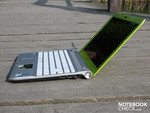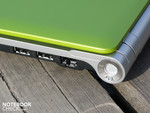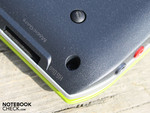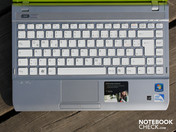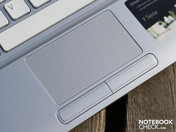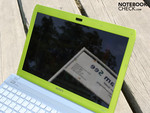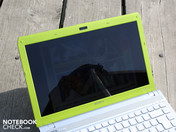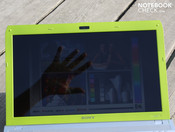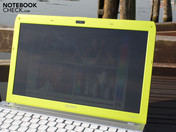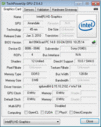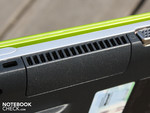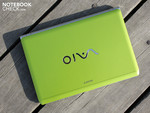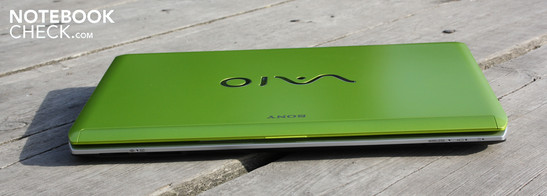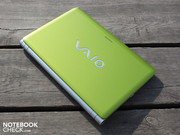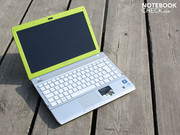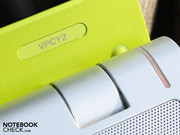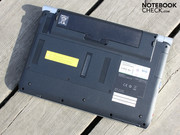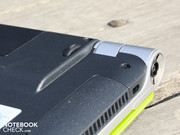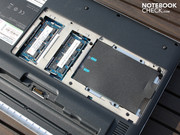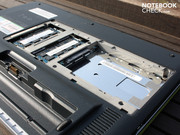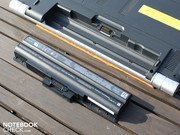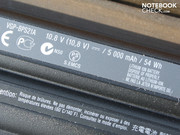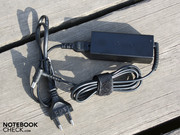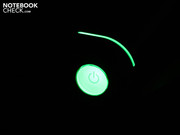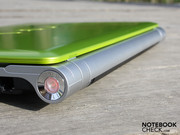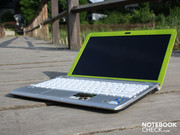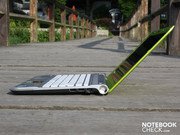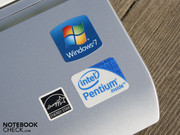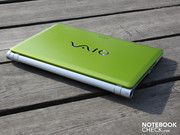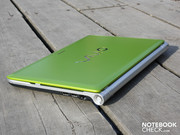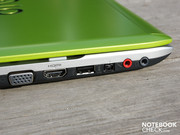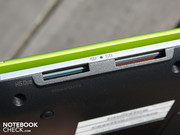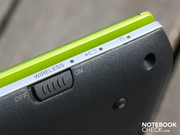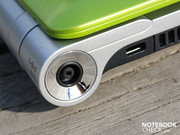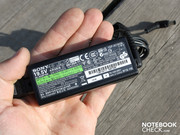Review Sony Vaio VPC-Y21S1E Subnotebook

Sony divided the old SR range into an S and Y series in the beginning of 2010. The Y devices address mobility-eager consumers, whereas the S range is conceived for trend-conscious business clients. Our first Y model, the Vaio VPC-Y11S1ES, is based on an Intel Core 2 Duo SU7300 (1.3 GHz). The manufacturer has changed the platform, but kept the successful concept. A Pentium U5400 (2x1.20 GHz) from Intel's new core generation does its job on the mainboard. The graphic card is also in this Pentium processor bundle, and not any longer in the chipset, like in the Y11S1ES (GMA 4500MHD).
Can we replicate the 9 hour battery life that Sony states? Can the workmanship convince us once again? Is the display finally suitable for outdoor use? And what is this Pentium U5400 with its meager 1.2 GHz actually capable of? All answers in our detailed review.
Case
Sony's Vaio Y21S1E is a bit lighter with 1694 grams than its 13.3 inch predecessor, Y11S1ES (1715 grams). The light subnotebook doesn't have a built-in optical drive. The case has been optimized for mobility and has a high torsional stiffness due to the aluminum/magnesium alloy. We couldn't twist the chassis with both hands and normal force.
The solid, yet light aluminum/magnesium alloy, which gives the base plate a very high stiffness by cross bracing, stands out here. The material makes a handy and high-end impression at the same time because of the hard, metallic surfaces (base plate). In our opinion, the perfect material for a base unit. A slight drawback is the battery: it wobbles slightly in its latch, but fits very secure due to the hinge on one axle.
The wrist-rest is very solid and doesn't allow denting anywhere. The same applies to the touchpad. The base plate's surfaces and the area above the keyboard don't yield anywhere. Not even under high pressure. This is only partly true for the key field. The surface yields selectively around the E-R-T area and the right shift key a bit.
The green, flat lid is adequately stiff. We can only twist it a bit when we pick it up at the corners. The manufacturer has improved the compressive strength of the lid surface. It can only be dent with considerable force. Due to the slight thickness, pressure points turn up immediately on the screen.
Both display hinges are mounted tight. The display stays reliably in place in every position (opening up to about 130 degrees). Jolts during train or car rides don't allow the lid to teeter. One hand suffices to open the lid, because the base unit stays put on the table.
The work area's matt surface is suitable as a mobile typewriter. The manufacturer has waived on the haptical punctures (Y11-predecessor), but the surfaces feel pleasantly dull and no fingerprints are left. The white keys on a silver background are the contrast points.
Connectivity
The Vaio VPC-Y21S1E's interfaces are distributed evenly on the right and left. The front has two cardreaders (SD and HG Duo) available right away. The rear is reserved for the battery unit.
The ports' positioning might just be unfavorable for left-handed mouse users. The VGA is directly beside HDMI on the left. The unwieldy cable (FireWire too) could be in the way of mouse utilization. Right-handed navigators have the advantage, as long as they don't equip the ExpressCard34 slot with a wired controller card.
FireWire (i.LINK) and audio ports are on the case's left side. FireWire is rather unusual in ULV subnotebooks. Video material from camcorders can quickly be transferred, but its editing (cut, sound) won't be much fun because of the low CPU performance. However, external hard disks can be used with FireWire, too.
An optical drive hasn't been built in, but the new VPC-Y21S1E buyer can organize one for free. After the new Vaio user's registration, Sony sends him the external DVD burner, DRX-S70U (value: 79 euro). The USB combo drive unfortunately doesn't have its own adapter and thus can't be used on the go. In return, the manufacturing is high-end and solid with a case of brushed aluminum. We looked at the drive in the test of the Y11S1ES . Information about the Sony Vaio action: www.sony.de/y-aktion.
Input Devices
Keyboard
The detached keys use almost the case's entire case and have a large gap in between. Pressure point and stroke length are crisp and clear. The key stroke is rather hard, but is appeased by the selectively easily yielding surface. We can recommend the keyboard to frequent typists due to the keys good grip and the very good typing feedback. Additionally, the key are in a small immersion. The hands lie on the elevated wrist-rest and practically hit the keys from above.
Touchpad
The touchpad is on the same level as the wrist-rest and is only delimited by a minute edge. The cursor moves accurately over the desktop when we glide over the matt, and sensitive up to the edge, surface. The pad can't be disabled via an FN key. It is a multi-touch pad (Synaptics V7.4). As such, it recognizes the use of two finger gestures. So, the user can, for example, zoom in and out or scroll up and down in Word documents or pictures. If you don't care much for that, you can scroll traditionally with one finger on the scroll bar (vertical, horizontal).
Display
The reflective display (type LFP 16) can't convince us with its low contrasts and the below average brightness. Sony builds a 13.3 inch (34 cm) display that has a resolution of 1366x768 pixels (16:9) in. This HD Ready resolution is suitable for the use as a mobile companion and standard for the size.
We reach a contrast of 223:1 with a black value of 0.81. Such a low rate is achieved by most office and multimedia notebooks and doesn't indicate a very high display quality. A higher contrast of over 400:1 would have been desirable, but isn't a major drawback in subnotebooks. Colors don't look as fresh and crisp as it would have been possible on the 13.3 incher.
| |||||||||||||||||||||||||
Brightness Distribution: 84 %
Center on Battery: 152 cd/m²
Contrast: 223:1 (Black: 0.81 cd/m²)
Our luminance meter records a brightness of 181 cd/m2. In view of the glare type screen and the targeted mobility, a luminosity of at least 250 cd/m2 would have been desirable. But the use in sunlight is connected to a quest for a shadowy place. The Vaio reduces the brightness to 152 cd/m2 (maximum center) in battery mode, which the user can't disable in the energy settings. The Y21 doesn't have a light sensor, as in the sister model S11.
The 13.3 inch screen is not a suitable outdoor companion with its glare-type characteristic and below average luminance (dimming in battery mode to 152 cd/m2). We only see a dark image outside in the sun from a frontal position. This effect is enhanced from the right or left. Working with the Y21 in sunlight is only possible with great effort. There are also annoying reflections because of the reflective TFT.
The horizontal viewing angles are acceptable. We can read script well up to a deviation of 45 degrees from a frontal position. However, the image has dimmed considerably by then (starts at 25 degrees).
If the user's view strays downwards (vertically), the displayed writing stays readable up to about 35 degrees. Colors, however, already falsify obviously starting at 10 degrees. It's similar for the luminance. The brightness already decreases at a deviation of a few degrees and dims quickly. A frontal viewing position is a premise for a perfect picture.
Performance
Intel has also brought new ultra low voltage alternatives onto the market with the new 2010 Arrandale processors. We've already seen the high-performance-i5-520UM in the Asus PL30JT-RO030X (13.3 inch). What does it now look like with a ULV processor that has Pentium as its prefix? In the past, Pentium CPUs were always weaker than similar clocking Core 2 Duo processors.
The Pentium U5400 (2x1.20 GHz, 3MB L2 cache) bears energy savings features of the new Arrandale generation. The CPU is manufactured in 32nm and has a TDP of 18 watts. That sounds like a lot, but the Intel HD graphics and the memory controller is included. Both are on the CPU bundle and simplify switching on the mainboard.
The Intel HD Graphics in the processor clocks dynamically with 166-500 MHz (Dynamic Frequency). Thus, it's a bit weaker than the Intel HD sisters in Core i3/i5 CPU that clock with up to 667 MHz. 3DMark2006 confirms that with a poor 1107 points. A "normal" Intel HD achieves 1300 to 1900 points depending on the CPU backing. The 3D performance is above the old GMA 4500MHD, but it's only enough for very undemanding gaming cases. It can support the processor in HD videos decryption (in the formats AVC/VC2/MPEG2) and thus provides for smooth HD movies. This hardware assistance has to be supported by the player/video editor.
The new Intel Core generation's performance characteristics are completely foreign to the Pentium U5400, though. No Turbo Boost, no hyperthreading and also no AES instruction (encryption) exist. Practically all qualities that we praised in the i5-520UM (Asus PL30JT-RO030X) are non-existent. Maybe that's why the Pentium CPU is on par with previous CULV Penryn processors?
Cinebench R10 Single (64bit) affirms this while computing with one core: 1691 points (Core 2 Duo SU7300: 1629; Pentium SU4100: 1542). The latter also has two cores and a very similar clock rate with 1.3 GHz.
The same result for computing on both cores. Cinebench R10 Multi (64bit) finishes with 3246 points (Core 2 Duo SU7300: 3054; Pentium SU4100: 2881). Short: The Pentium U5400's computational power has only increased measurably but not noticeably. The performance difference between the VPC-Y21S1E (present) and the VPC-Y11S1ES should thus be marginal.
| PCMark 05 Standard | 2641 points | |
| PCMark Vantage Result | 2852 points | |
Help | ||
Can PCMark Vantage confirm this assumption? It can. The VPC-Y211S1E is only above the predecessor still on the market, VPC-Y11S1ES, with a total score of 2852 points. This slight improvement is due to the somewhat faster Intel HD graphics (gaming score rises from 1700 to 2084 points) and by the faster hard disk (HDD score: 2899 to 3451 points).
We experience the overall system performance as smooth, which is especially due to the 320 GB hard disk. Several simultaneously running programs don't cause any latencies for the user. The 4 GB DDR3 RAM is another reason for that. The whole 4096 MB RAM can be used with Windows 7 64bit.
| 3DMark 03 Standard | 3061 points | |
| 3DMark 05 Standard | 2196 points | |
| 3DMark 06 Standard Score | 1107 points | |
Help | ||
The Toshiba hard disk (type MK3265GSX) of 320 GB works with a revolution speed of 5400 rpm. HDTune establishes a good 70.6 megabyte per second in sequential read. This throughput is above average. The SATA II hard disk didn't show any irregularities during operation.
Emissions
System Noise
A small notebook that we often carry around with us should be as inconspicuous as possible, and not disturb our neighbor with loud noise. Due to the Pentium CPU's low performance, a high noise level wouldn't be acceptable anyway. The 13.3 incher stays invariably quiet with 31 dB(A) in normal use. The fan frequently turns itself off and the remaining noise is caused by the hard disk (29.3 dB(A)). It's even likely that the fan isn't even noticed while surfing or looking at pictures.
The economical ULV components and the non-existent dedicated graphics also contribute to a low soundscape under load. If both cores of the Pentium U5400 are under load, we measure a maximum of 33.1 dB(A). The user won't ever experience more, because the room temperature during our tests was already higher than usual with 27 degrees. A stress test (Prime95+Furmark), which exploits the integrated Intel HD graphics and thus really drives the TDP up to 18 watts, brings the fan to a noticeable 37.1 dB(A).
Noise Level
| Idle |
| 29.3 / 31.1 / 31 dB(A) |
| HDD |
| 31.1 dB(A) |
| Load |
| 33.1 / 37.1 dB(A) |
 | ||
30 dB silent 40 dB(A) audible 50 dB(A) loud |
||
min: | ||
Temperature
The 13.3 incher heats up to a good 30 degrees on top and the bottom in idle and office mode. This is a low rate considering the high room temperature. The waste heat is higher than in the stress test in some areas. This is because of the very slow or not at all rotating fan in idle scenarios.
The Sony Y21S1E always stays considerably below the 40 degree mark during processor and graphics benchmarks. We determined 36 degrees Celsius at most on the work surface after a two hour stress test with CPU and GPU load. Our thermometer now selectively indicates 36.3 degrees on the base plate. The average is 34 degrees.
Even the most stressing benchmarks, like Prime95, can't get the Pentium U5400 to surpass 57 degrees. When the processor, with 1.20 GHz, is idle, then the operating temperature stays constant at 40 degrees Celsius.
(+) The maximum temperature on the upper side is 36 °C / 97 F, compared to the average of 35.9 °C / 97 F, ranging from 21.4 to 59 °C for the class Subnotebook.
(+) The bottom heats up to a maximum of 36.3 °C / 97 F, compared to the average of 39.4 °C / 103 F
(±) In idle usage, the average temperature for the upper side is 33.2 °C / 92 F, compared to the device average of 30.7 °C / 87 F.
(+) The palmrests and touchpad are reaching skin temperature as a maximum (33.2 °C / 91.8 F) and are therefore not hot.
(-) The average temperature of the palmrest area of similar devices was 28.3 °C / 82.9 F (-4.9 °C / -8.9 F).
Loudspeakers
The stereo loudspeakers placed above the keyboard supply a midrange-prone, slightly tinny sound. At least the loudspeakers don't scratch even at maximum volume. The volume is comparatively low in the highest level. The connection of external loudspeakers via the 3.5 millimeter jack becomes an important option. The notebook's tethered volume can be freely adjusted - there is no noise at a low output level.
Battery Life
Sony's 13.3 incher is very efficient in mobility due to the strong 5000 mAh battery and the economical energy balancing. However, it's not on the top of comparable CULV subnotebooks. The Vaio Y21 has to return to the mains after 8:07 hours (487 minutes) of idle. An Acer Aspire 1810TZ (11.6 inch), also with a CULV Pentium processor, achieves 12:40 hours (751 minutes, 64Wh) in the same exercise. The predecessor, VPC-Y11S1ES, with the same battery capacity is also evidently better than the test device with almost 11 hours (652 minutes).
WLAN surfing with a brightness around 100 cd/m2 is more expressive than the runtime in idle and lowest brightness. The battery is drained after 5:55 hours (355 minutes). We visited Google Maps and called up websites that put the processor under a load of 5 to 20 percent. The LED screen ran on medium level at 100 cd/m2 during these tests.
How long will a DVD movie play? Due to the lack of an optical drive, we opted for a run with a USB DVD drive with its own power supply. The movie fun first came to an end after six hours (367 minutes). The runtime would turn out lower with a USB DVD drive without an own adapter (powered over USB). Experience has shown that playing an AVI movie from the hard disk (not 720p/1080p material) only leads to an insignificantly lower runtime.
The subnotebook's power consumption is almost on a netbook level in idle (7.2 watt, maximum energy savings). Our voltmeter presented an average effective power of only 13.3 watts in normal idle, so in high performance mode with enabled wireless modules. Now we can see why the battery life has decreased in comparison to the predecessor, VPC-Y11S1ES (SU7300). The Core 2 Duo version, Y11, needs 6.6 to 11.4 watts (idle savings / idle maximum).
Even the maximum power consumption points out that the new Y model isn't any more economical than the old one: 30.0 versus 31.8 watts. These number games shouldn't deter potential buyers, though. Typical mainstream notebooks, like the Acer Aspire 5741G-334G50Mn (i3-330M) draw even more power out of the socket with 10/21.4 watts (idle saving / idle maximum). Seen on the whole, even standard laptops have become very saving.
| Off / Standby | |
| Idle | |
| Load |
|
Verdict
Graphic card? I don't need one. Those who agree with this opinion and concentrate on the really important issues, might take a liking to the Vaio Y21S1E for 770 euro. The ULV components, like Intel Pentium U5400 (1.2 GHz) and DDR3 RAM and the 5000 mAh battery prompt the 13.3 incher to a good battery life (WLAN almost six hours). The Vaio doesn't come close to the top mobility rates of some competitor subnotebooks (Asus UL30A, WLAN) with 7:25 hours, though. An even stronger battery would have been needed for this.
The Sony Y21S1E continues to keep up the mood in terms of emissions. The waste heat is always acceptable, even under load. The system noise is usually not even audible in undemanding mobile mode.
We were almost ecstatic about the light magnesium case (1694 grams). It's surprisingly stable despite the low weight. Sony has improved the lid's stability in comparison to the X11 predecessor. The matt and grippy surfaces on the bottom are suitable for serious workday routine.
In our opinion, the reflective and too dark LED screen is extremely detrimental to mobility. The glare type display only has a brightness of 181 cd/m2. That decreases to a low 152 cd/m2 in battery mode (center). It would have needed a much brighter anti-glare screen for the use in a cafe.
Sony Vaio Y21S1E/G bei Amazon kaufen - ab 799,00 Euro


 Deutsch
Deutsch English
English Español
Español Français
Français Italiano
Italiano Nederlands
Nederlands Polski
Polski Português
Português Русский
Русский Türkçe
Türkçe Svenska
Svenska Chinese
Chinese Magyar
Magyar